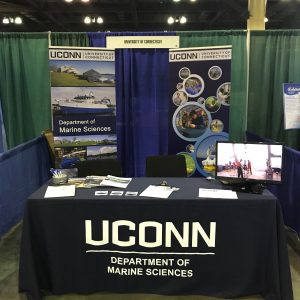A new website highlighting the Long Island Sound Habitat Mapping Initiative went live on Earth Day. The website provides information on the background and motivation for the mapping initiative, summaries of the field work conducted, interpretive story maps describing some of the results, links to data products and publications generated and multimedia links to images and video of at-sea operations that illustrate the beauty and complexity of the underwater habitats of the Sound.
DMS post-doctoral researcher Emma Cross publishes new brachiopod research
15 April 2019. Dr. Emma Cross from the Baumann Lab just published her latest paper about brachiopod resilience to future ocean acidification in Environmental Science & Technology. The project involved long-term culturing of a polar and a temperate brachiopod under future ocean acidification and warming conditions during Emma’s PhD-research with the British Antarctic Survey. Substantial shell dissolution posed a threat to both species under ocean acidification, with more extensive dissolution occurring in the polar species.
Unexpectedly, however, the authors also discovered that brachiopods thicken their shell from the inner shell surface when extensive dissolution occurs at the outer shell surface under ocean acidification. This important finding furthers our understanding how predicted vulnerable marine calcifiers might cope under future environmental change.
Cross, E. L., Harper, E. M. and Peck, L. S. 2019. Thicker shells compensate extensive dissolution in brachiopods under future ocean acidification. Environmental Science & Technology (published online March 29, 2019).
New publication of mercury levels in aquatic wildlife and the atmosphere
-
- Wang, F., Outridge, P.M., Feng, X., Meng, B., Heimbürger-Boavida, L.-E., and Mason, R.P. (2019)
How closely do mercury trends in fish and other aquatic wildlife track those in the atmosphere? – Implications for evaluating the effectiveness of the Minamata Convention
Science of The Total Environment 674:58-70
Canadian Journal of Zoology publishes perspective on experimental OA research by DMS faculty

- Baumann, H. (2019)
Experimental assessments of marine species sensitivities to ocean acidification and its co-stressors: how far have we come?
Canadian Journal of Zoology 97:399-408
Grad students Sean Ryan and Halle Berger win awards at 2019 Benthic Ecology Meeting
Graduate students Sean Ryan and Halle Berger received Honourable Mention awards (top 10 graduate student presentations) for their presentations at the 2019 Benthic Ecology Meeting in St. John’s Newfoundland. Halle Berger, co-advised by Profs. Samantha Siedlecki and Catherine Matassa, was awarded for her interdisciplinary talk “Using regional oceanographic forecasts to assess the vulnerability of the Dungeness crab to climate change stressors.” Sean Ryan (advisor Catherine Matassa) was awarded for his poster “Induced herbivore resistance varies with latitude in the rockweed Fucus vesiculosus.” Sean and Halle were among ~180 student presenters at the meeting. Congratulations on your accomplishments, Halle and Sean!
New hydrothermal scavenging paper published in EPSL
The Lund lab recently published a paper in Earth and Planetary Science Letters on hydrothermal scavenging of trace metals at the East Pacific Rise. The results suggest that 230Th, a radionuclide commonly used to constrain sediment accumulation rates on the seafloor, is highly sensitive to changes in hydrothermal output, with important implications for the use of 230Th in paleoclimate and geochemical studies (https://davidlund.wixsite.com/averypointpaleo/page4).
Citizen science shows that climate change is rapidly reshaping Long Island Sound
21 March 2019. Marine Environmental Research just published a study about long-term ecological change in eastern Long Island Sound based on data collected by Project Oceanology! This non-profit ocean literacy organization has educated middle and high school students on boat trips to nearby estuarine sites for decades. For the first time, the digitization of these data allowed their quantitative evaluation, offering insights into the abiotic and biotic changes in nearshore waters of Eastern Long Island Sound.
Highlights
-
- Citizen-science observations revealed rapid warming, acidification, and dissolved oxygen loss over the past 40 years in eastern Long Island Sound
- Otter trawl catches showed significant decreases in overall species diversity and richness
- Cold-water adapted species (American lobster, winter flounder) decreased, but warm-water adapted species (spider crabs) increased since 1997
Undergraduate Students Unravel Challenges to Predicting Zooplankton Vulnerability to Warming
Mentored by Professor Hans Dam and Ph.D. student Matthew Sasaki, Undergraduate students Sydney Hedberg and Kailin Richardson (participants in the UConn-Mystic Aquarium Research-Experience-for-Undergraduates Program, http://www.mysticaquarium.org/reu/) carried out experiments that yield important insights into how zooplankton respond to warming. The results of the work are now published in the journal Royal Society Open Science (https://royalsocietypublishing.org/doi/10.1098/rsos.182115). The research shows that predicting the vulnerability of populations to global warming involves complex interactions between evolutionary adaptation, phenotypic plasticity, and sex (females rule !). The paper has two important implications. Surprisingly, tropical populations are more at risk because animals are already living near their thermal limits. In addition, because of the low survival of males, populations facing warming may be limited by the ability of males to fertilize females.
Photos by Hans Dam
ASLO 2019 Aquatic Sciences Meeting well attended by UConn Department of Marine Sciences
More than 15 faculty members, graduate students, and undergraduates from the Department of Marine Sciences presented their research at last week’s ASLO (Association for the Sciences of Limnology and Oceanography) 2019 Aquatic Sciences Meeting in San Juan Puerto Rico. DMS presentations reflected the diversity of our faculty’s research disciplines and approaches, including coral reefs, plankton ecology and physiology, nitrogen cycling, microplastics, salt marshes, and ecosystem impacts of storm events.
2019 Quahog Bowl
Faculty, staff, students, and alumni of the Department of Marine Sciences participated in the 22nd annual Quahog Bowl held on UConn’s Avery Point campus. This year, sixteen high-school teams competed in the event which is a regional competition for the National Ocean Sciences Bowl. Members of the Department served as science judges, science graders, score keepers, and in other capacities at the annual event. The competition was fierce, and in the end the team from Science and Technology Magnet School A (New London, CT) won by besting the team from Coginchaug Regional High School (Durham, CT). Overall, all teams had a fun and educational day.
https://seagrant.uconn.edu/2019/01/24/16-teams-to-compete-in-22nd-annual-quahog-bowl-on-feb-2/
https://seagrant.uconn.edu/2019/02/05/nl-team-captures-first-quahog-bowl-win-heads-to-nationals/







